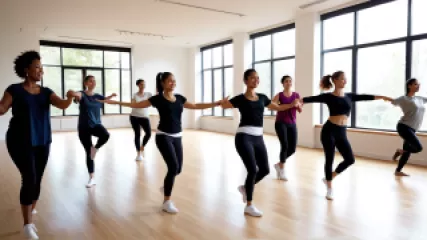How to Get Started with Dance Movement Therapy: Step by Step Guide
Dance Movement Therapy (DMT) is an expressive form of therapy that uses dance and movement to support mental, emotional, and physical well-being. It has been gaining recognition as a powerful therapeutic tool for individuals of all ages and backgrounds.
This guide will walk you through the steps needed to get started with dance movement therapy, whether you're looking to practice on your own, join a group, or seek professional guidance. Each section will provide detailed information to help you understand and implement DMT effectively.
Understanding Dance Movement Therapy
What is Dance Movement Therapy?
Dance Movement Therapy (DMT), also known as dance therapy, is a form of psychotherapy that employs movement and dance to improve emotional, cognitive, physical, and social integration. Unlike traditional talk therapy, DMT emphasizes non-verbal communication, allowing individuals to express their feelings and experiences through body movements.
"Dance is the hidden language of the soul." Martha Graham
DMT can be practiced individually or in groups and is often led by a certified dance therapist. The approach is holistic, considering the individual as a whole—mind, body, and spirit. This makes it particularly effective for addressing a wide range of issues, from stress and anxiety to trauma and depression.
Benefits of Dance Movement Therapy
The benefits of dance therapy for mental health are numerous and well-documented. Some of the key advantages include:
- Emotional Expression: DMT provides a safe space for expressing emotions that may be difficult to articulate verbally.
- Stress Reduction: Engaging in rhythmic movements can help reduce stress and promote relaxation.
- Improved Self-Esteem: The creative expression and mastery of new movements can boost self-confidence.
- Enhanced Social Skills: Group sessions foster a sense of community and improve interpersonal skills.
- Physical Health: Regular movement enhances physical fitness, flexibility, and coordination.
These benefits make DMT a versatile and effective form of therapy for various populations, including children, adults, and the elderly.
Getting Started with Dance Movement Therapy
Step 1: Understand Your Needs
Before diving into dance movement therapy, it's essential to understand your specific needs and goals. Are you looking to alleviate stress, manage anxiety, or improve social skills? Defining your objectives will help you choose the right approach and make the most out of your DMT experience.
Consider keeping a journal to document your thoughts, feelings, and goals. This will not only provide clarity but also serve as a valuable resource to track your progress over time.
Step 2: Research Different Approaches
There are various approaches to dance movement therapy, each with its unique techniques and philosophies. Some of the most common approaches include:
- Authentic Movement: Focuses on spontaneous movement and self-awareness.
- Choreotherapy: Involves structured dance routines to address specific issues.
- Ecstatic Dance: Emphasizes free-form movement and emotional release.
- Body-Mind Centering: Combines movement with mindfulness practices.
Research these approaches to find one that resonates with you. You may also consider trying multiple methods to see which one aligns best with your needs and preferences.
Step 3: Find a Certified Dance Therapist
If you're new to dance movement therapy, working with a certified dance therapist can provide valuable guidance and support. A trained therapist will have the expertise to tailor sessions to your specific needs and ensure a safe and effective therapeutic experience.
To find a certified dance therapist:
- Check professional organizations like the American Dance Therapy Association (ADTA).
- Ask for recommendations from healthcare providers or mental health professionals.
- Read reviews and testimonials to gauge the therapist's reputation and effectiveness.
When selecting a therapist, consider scheduling an initial consultation to discuss your goals and assess whether their approach aligns with your needs.
Preparing for Your First Session
Step 4: Set Realistic Expectations
It's important to approach your first DMT session with an open mind and realistic expectations. Remember that therapy is a process, and it may take time to see significant changes. Be patient with yourself and trust in the journey.
Discuss your expectations with your therapist during the initial consultation. This will help both of you align your goals and develop a tailored plan for your therapy sessions.
Step 5: Choose Comfortable Clothing
Wearing comfortable clothing is crucial for dance movement therapy. Opt for loose-fitting garments that allow for a full range of motion. Avoid restrictive clothing or accessories that might hinder your movements.
Footwear is also an important consideration. Depending on the type of DMT, you may be asked to dance barefoot or wear specific types of shoes. Consult with your therapist to determine the best options for your sessions.
Step 6: Create a Safe Space
If you're participating in online dance movement coaching or practicing at home, creating a safe and comfortable space is essential. Ensure that you have enough room to move freely and that the area is free from obstacles and distractions.
Consider adding elements that enhance your comfort and relaxation, such as soft lighting, calming music, or aromatherapy. A well-prepared space will help you fully immerse yourself in the therapeutic experience.
During the Session
Step 7: Warm-Up Exercises
Most DMT sessions begin with warm-up exercises to prepare your body and mind for movement. These exercises are designed to increase blood flow, improve flexibility, and reduce the risk of injury.
Common warm-up activities include:
- Gentle stretching
- Breathing exercises
- Slow, rhythmic movements
Your therapist will guide you through these exercises, ensuring that they are appropriate for your fitness level and any physical limitations you may have.
Step 8: Engage in Guided Movements
During the main part of the session, your therapist will introduce guided movements and exercises tailored to your goals. These movements may be structured or improvisational, depending on the approach being used.
Some common techniques include:
- Mirroring: Mimicking the therapist's movements to foster connection and empathy.
- Imagery: Using visualizations to inspire and direct movements.
- Improvisation: Encouraging spontaneous and creative movements.
As you engage in these movements, focus on your body's sensations and emotions. Allow yourself to move freely without judgment or self-criticism.
Step 9: Reflect and Process
Reflection is a vital component of dance movement therapy. After the movement portion of the session, you'll have the opportunity to reflect on your experiences and emotions. This may involve verbal discussions, journaling, or other forms of creative expression.
Reflection helps you gain insights into your feelings and behaviors, fostering self-awareness and personal growth. Your therapist will guide you through this process, helping you make connections between your movements and your emotional state.
Incorporating Dance Movement Therapy into Your Life
Step 10: Practice Regularly
Consistency is key to reaping the benefits of dance movement therapy. Aim to incorporate DMT into your routine regularly, whether through scheduled sessions with a therapist or self-guided practice at home.
Set aside dedicated time for DMT, and treat it as an essential part of your self-care regimen. Regular practice will help reinforce the positive effects of therapy and support your overall well-being.
Step 11: Explore Online Resources
With the rise of online dance mindfulness sessions and virtual coaching, you have access to a wealth of resources to enhance your DMT practice. Online platforms offer classes, tutorials, and guided sessions led by experienced therapists and instructors.
Take advantage of these resources to supplement your in-person sessions or explore new techniques and approaches. Whether you're a beginner or an experienced practitioner, online resources can provide valuable support and inspiration.
Step 12: Join a Community
Connecting with others who share your interest in dance movement therapy can be incredibly rewarding. Joining a community or support group allows you to share experiences, exchange ideas, and build lasting friendships.
Look for local or online communities dedicated to DMT. Participating in group activities and discussions can enhance your motivation and provide a sense of belonging.
Overcoming Challenges
Step 13: Addressing Self-Consciousness
Feeling self-conscious or vulnerable is a common challenge when starting dance movement therapy. It's natural to feel hesitant about expressing yourself through movement, especially if you're new to the practice.
Here are some tips to overcome self-consciousness:
- Focus on the Experience: Shift your attention from how you look to how you feel.
- Practice Self-Compassion: Be kind to yourself and embrace imperfections.
- Set Small Goals: Start with simple movements and gradually build confidence.
- Seek Support: Talk to your therapist about your concerns and work together to create a supportive environment.
Remember, DMT is a personal journey, and there's no right or wrong way to move. Allow yourself the freedom to explore and experiment without judgment.
Step 14: Managing Physical Limitations
Physical limitations or health conditions can pose challenges in dance movement therapy. However, DMT is highly adaptable and can be modified to suit individual needs and abilities.
Communicate openly with your therapist about any physical limitations or health concerns. They can design a personalized program that accommodates your needs and ensures a safe and effective therapeutic experience.
Additionally, consider integrating complementary practices such as yoga, tai chi, or gentle stretching to enhance your flexibility and mobility.
Expanding Your Practice
Step 15: Explore Advanced Techniques
As you become more comfortable with dance movement therapy, you may wish to explore advanced techniques and practices. These can deepen your understanding of DMT and provide new avenues for personal growth and healing.
Some advanced techniques to consider include:
- Somatic Experiencing: Focuses on releasing trauma stored in the body.
- Contact Improvisation: Involves shared movement and physical contact with a partner.
- Laban Movement Analysis: Analyzes movement patterns and qualities to enhance self-awareness.
- Expressive Arts Therapy: Combines dance with other creative modalities such as art, music, and drama.
Working with an experienced therapist or instructor can help you navigate these advanced techniques and integrate them into your practice.
Step 16: Attend Workshops and Retreats
Workshops and retreats offer immersive experiences that can significantly enhance your dance movement therapy practice. These events provide opportunities to learn from experts, connect with like-minded individuals, and explore new approaches in a supportive environment.
Look for workshops and retreats that align with your interests and goals. Many events cater to specific themes or populations, such as trauma recovery, mindfulness, or creative expression.
Attending these events can rejuvenate your practice and inspire new insights and perspectives.
Final Thoughts
Dance movement therapy is a transformative and empowering practice that offers numerous benefits for mental, emotional, and physical well-being. By following the steps outlined in this guide, you can embark on a fulfilling journey of self-discovery and healing through movement.
Whether you're a beginner or an experienced dancer, DMT provides a unique and holistic approach to therapy that can enrich your life in profound ways. Embrace the process, stay open to new experiences, and allow yourself to move freely and authentically.
Remember, the path to well-being is a continuous journey, and dance movement therapy can be a valuable companion along the way. So, take the first step, and let the dance begin!






